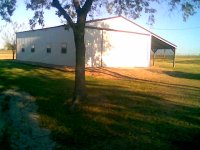Chris2
Bronze Member
So my last wooden pole barn (30x30x10) didn't sweat at all, doors faced north and south. My new all metal building (40x50x16) with two doors facing west and one facing east sweats like crazy. Not really sweating but condensation, all over everything this time of year. Ill literally have beaded up water all over anything metal.
So my question is do you guys think a 1700 CFM exhaust fan would help? Should i mount it up high near the roof, midway up the wall?
Close behind the East wall with one door there is a creek bottom and a pond. From the West wall with two doors the elevation is all up hill. Should I mount the fan blowing out of the East wall so as to not pull in the damp air from the creek bottom?
Thanks for the help.
Louisiana weather!
So my question is do you guys think a 1700 CFM exhaust fan would help? Should i mount it up high near the roof, midway up the wall?
Close behind the East wall with one door there is a creek bottom and a pond. From the West wall with two doors the elevation is all up hill. Should I mount the fan blowing out of the East wall so as to not pull in the damp air from the creek bottom?
Thanks for the help.
Louisiana weather!
